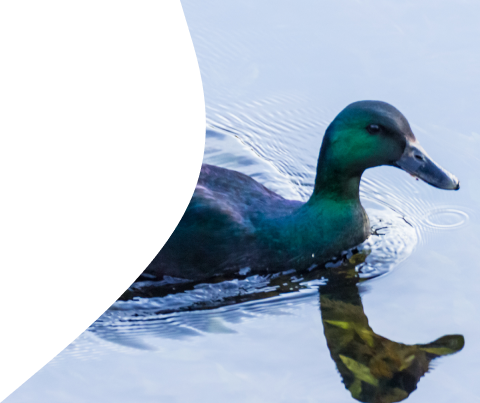
The Cayuga duck, known for its striking iridescent black feathers, is a hardy and quiet breed native to the U.S. Named after Lake Cayuga in New York, this breed has been domesticated for centuries. Their rich greenish-black plumage makes them stand out, and they are valued for both meat and eggs. Cayuga ducks are often raised by backyard duck enthusiasts, homesteaders, and small farmers due to their calm demeanor and adaptability to various climates.
- Dark to black, matching their unique plumage.
- Iridescent black-green feathers that shimmer in sunlight, giving a metallic green look.
- Older Cayugas may get white feathers after molting

BREED & ORIGIN
Lake Cayuga, New York, U.S.

LIFE EXPECTANCY
8 to 12 years

HEIGHT & WEIGHT
Drakes weigh 7-8 lbs (3.2-3.6 kg)
Hens weigh 6-7 lbs (2.7-3.2 kg)

Duckling: 6-8 weeks

Juvenile: 8 weeks to 4-5 months

Adult: 6 months
LOW
MEDIUM
HIGH
Temperament
Calm, friendly, not aggressive
Activity Level
Moderate; good foragers
Climate Tolerance
Hardy; cold and heat tolerant
Genetic Traits
Iridescent black-green, Dark, black webbed feet
Egg Laying Capacity
Moderate; 100-150 eggs per year
Broodiness
Females often sit on eggs and raise young

Feeding
These ducks thrive on a balanced diet of grains, seeds, and plants. Cayugas are good foragers, supplementing their diet with insects and small invertebrates.

Housing
Cayugas prefer outdoor living but should have access to a pond or shallow water source for bathing and foraging. They need a dry, secure shelter to protect them from predators and extreme weather.

Health
Cayuga ducklings are independent and can forage early but still require warmth and protection during the first few weeks of life.

Breeding Practices
Cayuga ducks breed easily, with females laying up to 13 eggs per clutch. Females are broody, often sitting on their eggs and raising their young without much human intervention.
Nutritional Needs
Cayuga ducks require a balanced diet with high-protein starter feed (18-20%) for ducklings, followed by grower feed (15-16%) until maturity, and layer feed with added calcium for adult females to support egg production. Free-ranging for insects and greens supplements their diet, while fresh veggies, grains, and occasional fruits make good treats. Clean water is essential to aid digestion and keep their nostrils clear.

Cayuga ducks hold economic value for small farms due to their dual-purpose nature, providing both meat and eggs. Culturally, they’re prized in the U.S. as one of the few American duck breeds, celebrated for their unique, dark-feathered beauty and role in preserving heritage breeds.
Category |
Details |
|---|---|
Breed |
Cayuga Duck |
Origin |
Lake Cayuga, New York, U.S |
Temperament |
Calm, friendly, not aggressive |
Common Health Issues |
Generally healthy; prone to common poultry diseases if not kept clean |
Commercial Use |
Meat and egg production |
Climate Tolerance |
Hardy; cold and heat tolerant |
Conservation Efforts |
Watchlist (due to declining population) |
Fertility Rates |
High; broody females |
Backyard Use |
Suitable for backyard flocks |
Egg Laying |
Moderate; 100-150 eggs per year |
Life Cycle |
8-12 years |
Broodiness |
Females often sit on eggs and raise young |
- Quiet, calm, and friendly, making them suitable for small backyard flocks.
- Hardy and adaptable to various climates, including cold winters.
- Unique black plumage and occasional black eggs add novelty.
- Good foragers, able to supplement their diet naturally.
- Excellent broody mothers who raise their own ducklings.
- Not as prolific in egg production compared to commercial laying breeds.
- May require more space if kept in smaller backyard settings.
- Older birds may lose their unique black coloration and develop white feathers.

Yes, Cayuga ducks make excellent pets due to their friendly and calm nature. They
are gentle and enjoy interacting with humans, making them suitable for families and backyard settings. Their easy going demeanor also makes them manageable companions, even for those new to duck-keeping.